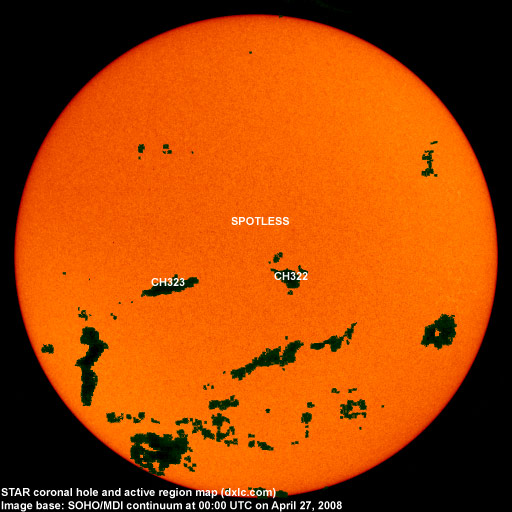

Last major update issued on April 27, 2008 at 05:45 UTC.
[Solar and
geomagnetic data - last month (updated daily)]
[Solar wind and
electron fluence charts (updated daily)
[Solar cycles 21-23
(last update October 4, 2007)]
[Solar cycles 1-20]
[Graphical comparison
of cycles 21, 22 and 23 (last update October 4, 2007)]
[Graphical
comparison of cycles 2, 10, 13, 17, 20 and 23 (last update October 4, 2007)]
[Historical solar and
geomagnetic data charts 1954-2006 (last update April 5, 2007)]
[Archived reports
(last update April 7, 2008)]
The geomagnetic field was quiet to unsettled on April 26. Solar wind speed ranged between 447 and 479 km/s under the influence of a high speed stream from CH321.
Solar flux measured at 20h UTC on 2.8 GHz was 69.0. The planetary A index was 10 (STAR Ap - based on the mean of three hour interval ap indices: 10.0). Three hour interval K indices: 22232332 (planetary), 23232332 (Boulder).
The background x-ray flux is below the class A1 level.
At midnight the visible solar disk was spotless. The solar flare activity level was very low.
April 24-25: No partially or fully Earth directed CMEs were observed.
April 26: A partial halo CME was observed in LASCO C3 images following a
filament eruption in the northern hemisphere (location: N08E08) at 13:54 UTC.
Most of the ejected material was observed off of the northeast limb.
Coronal hole
history (since late October 2002)
Compare today's report to the situation one solar rotation ago:
28
days ago
27
days ago
26
days ago
A recurrent trans equatorial coronal hole (CH321) was in an Earth facing position on April 21-23. What used to be a recurrent coronal hole (CH319) has decayed quickly over the last solar rotation. Two small coronal holes are currently the only remains of CH319, both are in the southern hemisphere. CH322 was in an Earth facing position late on April 26 and CH323 will be Earth facing on April 28.

Processed SOHO/EIT 195 image at 00:24 UTC on April 27. The darkest areas on the solar disk are likely coronal holes.
Long distance low and medium frequency (below 2 MHz) propagation along paths north of due west over high and upper middle latitudes is poor. Propagation on long distance northeast-southwest paths is poor to fair.
The geomagnetic field is expected to be quiet to unsettled on April 27 due to effects from CH321 and quiet on April 28. A CME observed on April 26 could cause unsettled to active conditions on April 29. Weak effects from CH322 are possible on April 30 and from CH323 on May 1-2.
| Coronal holes (1) | Coronal mass ejections (2) | M and X class flares (3) |
1) Effects from a coronal hole could reach Earth
within the next 5 days. When the high speed stream has arrived the
color changes to green.
2) Effects from a CME are likely to be observed at Earth within 96
hours.
3) There is a possibility of either M or X class flares within the next
48 hours.
Green: 0-20% probability, Yellow: 20-60% probability, Red: 60-100% probability.

Compare to the previous day's image.
Data for all numbered solar regions according to the Solar Region Summary provided by NOAA/SWPC. Comments are my own, as is the STAR spot count (spots observed at or inside a few hours before midnight) and data for regions not numbered by SWPC or where SWPC has observed no spots. SWPC active region numbers in the table below and in the active region map above are the historic SWPC/USAF numbers.
| Active region | Date numbered | SWPC spot count |
STAR spot count |
Location at midnight | Area | Classification | Comment |
|---|---|---|---|---|---|---|---|
| 10991 | 2008.04.19 | S10W63 | plage | ||||
| 10992 | 2008.04.22 | N13W58 | plage | ||||
| Total spot count: | 0 | 0 | |||||
| SSN: | 0 | 0 | |||||
| Month | Average solar flux at Earth |
International sunspot number | Smoothed sunspot number |
|---|---|---|---|
| 2000.04 | 184.2 | 125.5 | 120.8 cycle 23 sunspot max. |
| 2000.07 | 202.3 | 170.1 | 119.8 |
| 2001.12 | 235.1 | 132.2 | 114.6 (-0.9) |
| 2007.02 | 77.7 | 10.7 | 11.5 (-0.4) |
| 2007.03 | 72.2 | 4.5 | 10.7 (-0.8) |
| 2007.04 | 72.4 | 3.4 | 9.8 (-0.9) |
| 2007.05 | 74.4 | 11.7 | 8.6 (-1.2) |
| 2007.06 | 73.7 | 12.1 | 7.6 (-1.0) |
| 2007.07 | 71.6 | 9.7 | 6.9 (-0.7) |
| 2007.08 | 69.1 | 6.0 | 6.0 (-0.9) |
| 2007.09 | 67.1 | 2.4 | 5.9 (-0.1) |
| 2007.10 | 67.4 | 0.9 | (6.3 predicted, +0.4) |
| 2007.11 | 69.6 | 1.7 | (6.5 predicted, +0.2) |
| 2007.12 | 78.5 | 10.1 | (6.6 predicted, +0.2) |
| 2008.01 | 74.3 | 3.4 | (7.0 predicted, +0.4) |
| 2008.02 | 71.1 | 2.1 | (7.9 predicted, +1.0) |
| 2008.03 | 72.9 | 9.3 | (9.4 predicted, +1.5) |
| 2008.04 | 70.6 (1) | 4.5 (2) | (10.8 predicted, +1.4) |
1) Running average based on the
daily 20:00 UTC observed solar flux
value at 2800 MHz.
2) Unofficial, accumulated value based on the Boulder (NOAA/SWPC) sunspot number. The official international sunspot number is typically
30-50% lower.
This report has been prepared by Jan Alvestad. It is based partly on my own observations and analysis, and partly on data from some of these solar data sources. All time references are to the UTC day. Comments and suggestions are always welcome.
| [DX-Listeners' Club] |